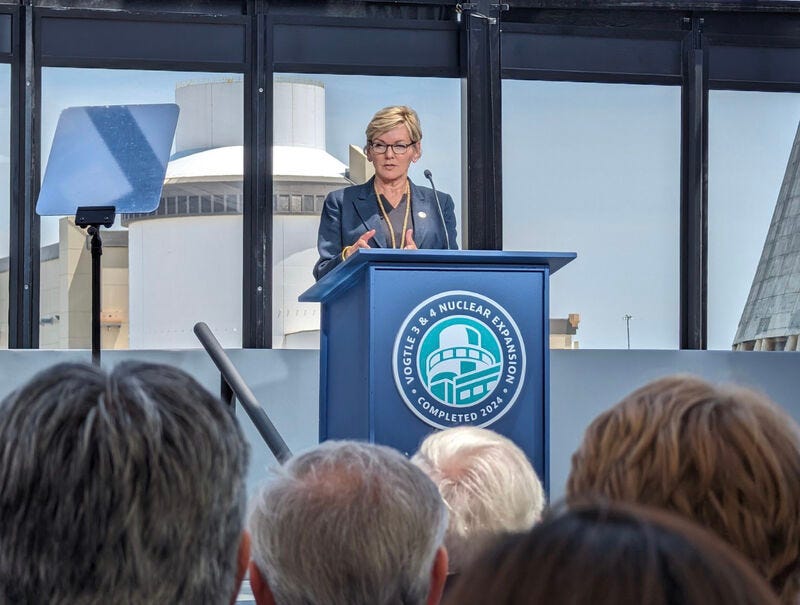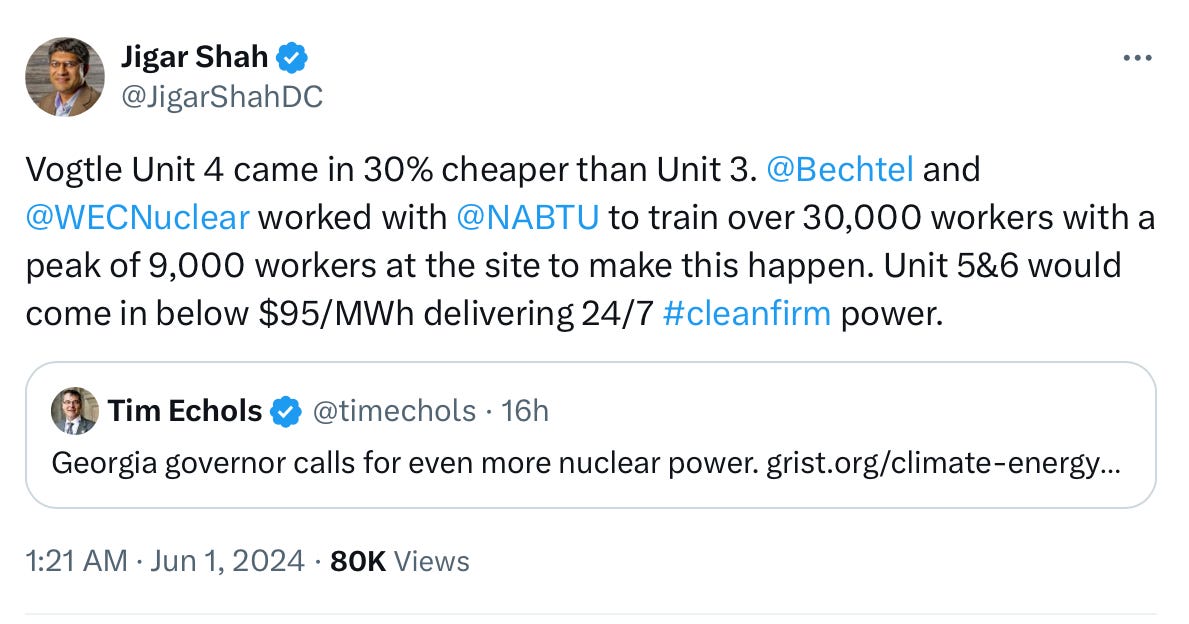The Era of Big Nuclear Is Back
America intends to add “hundreds” of new big beautiful reactors as Vogtle 3 & 4 officially crosses the finish line.

Everybody knows that the cup for a medium milkshake is only a little bit narrower than the cup for an extra-large. But the XL cup holds a lot more milkshake. But for years this intuitive, physical and incontrovertible truth was kind of forgotten. The nuclear sector sought a new thesis that small is beautiful and we need brand new technology to bring forth a real nuclear renaissance in the USA.
The reason why people thought this was the disastrous new-build efforts at Plant Vogtle in Georgia and VC Summers in South Carolina. America’s first attempts at constructing gigawatt-scale light-water reactors after decades of inaction blew out the budget and timeline and was rife with setbacks so severe the companies that tried to build them fell like skittles.
That is why the ultimate completion of Vogtle 3 & 4, a pair of Westinghouse 1,100MW AP-1000 reactors, also bought a turnaround in thinking about large reactors.
At the celebration, US Department of Energy (DOE) Secretary Jennifer Granholm called for “hundreds” of large nuclear reactors to be built.
"We need two hundred of these by 2050. Two down, one hundred and ninety-eight to go."
“Let’s start the planning for Vogtle 5”
I believe it was 2022 when I first made myself an absolute pest on US DOE folk’s mentions and inboxes. But why? But why? But why aren’t we building more AP1000’s? Why is it all “SMR and advanced” when we’ve got a proven design and large reactors are the most cost-effective way to build nuclear? Now the answer is clear: Vogtle wasn’t done yet and so we weren’t ready for that conversation.
Another key factor is the rapid emergence of AI as a source of demand for massive amounts of extremely steady power supply. Data centers look for “five nines” energy, that is 99.999% uptime. In any given year, they can tolerate 5 minutes of outage. Of course we can’t forget that electrification as a strategy for decarbonization was already poised to surge load growth, which had been stagnant in the US for many years.
The pair of AP-1000 reactors at Vogtle took too long and cost too much, but they were the First-of-a-kind builds in the US. According to Director of the Loan Programs Office (LPO) at the DOE Jigar Shah, Vogtle Unit 4 came in 30% cheaper than Unit 3 and Unit 5 & 6 would come in “below $95/MWh,” a very tidy price for clean firm power and favorable compared to current US offshore wind cost of energy.
Governor Brian Kemp of Georgia, speaking at yesterday’s celebration said “Vogtle 3 and 4 don’t just represent an incredible economic development asset for our state and a milestone for our entire country, they also stand as physical examples of something that I remind myself of every day: Tough times don’t last. Tough people do.”
“Let’s start planning for Vogtle Five.”
Counting the COLs
I can well-understand why the intent to build more large reactors came after Vogtle 3 & 4 finally crossed the finish line and not before, but the clock is ticking. The precious pool of skilled workers and supply-chain built up will disperse if not transferred in a timely manner to a new build.
The fastest projects to get shovel-ready for new builds would be the projects that already have COLs —Combined Licenses. According to the US NRC the following projects have COLs that are active, meaning they already have the regulatory agency’s blessings to proceed.
Fermi 3 (Michigan, ESBWR)
North Anna 3 (Virginia, ESBWR)
William States Lee III, Unit 1 and 2 (South Carolina, AP-1000)
Turkey Point, Unit 6 and 7 (Florida, AP-1000)
ESBWR stands for Economic Simplified Boiling-Water Reactor and they haven’t been built and proven. This leaves the two AP-1000 projects remaining as the natural focus for possible next builds. Governor Kemp also mentioned the possibility of Vogtle 5 & 6 although there are no COLs on the NRC site for those projects.
There are more COLs that have been terminated by the request of the licensees and it’s unknown whether they can be returned to active status. It’s worth noting here that these COLs have been issued and the projects sitting around for years, undermining the narrative that it’s the US regulator that’s been holding back growth for new nuclear in the US. Of course, many more COLs will have to be issued in the future to fulfill the buildout envisaged by the DOE and time will tell if the NRC can deal with those expeditiously.
Small for a reason is still beautiful
As we celebrate the return to big nuclear, we shouldn’t throw away all the little reactors we’ve come to love along the way, we just have to think about them the right way.
SMRs are awesome, but niche. You build SMRs when you have a reason. Is it a small grid? A remote location? Do you need industrial heat? Are you leveraging existing infrastructure like a coal drop-in? Otherwise it’s like almost anything else: scale matters.
Who knows, maybe one day in the future a SMR or micro reactor will even finally prove the “factory-made and mass cost down” thesis. But I know that day will not come soon, and that’s alright, because LMRs — Large Modular Reactors like the AP-1000 and the Advanced Boiling Water Reactor (ABWR) works just fine. 🍑





When I heard that SMRs might need to build several GW to pay down factory investments it clicked for me. Their first of a kind models are likely to cost plenty. And at those prices the financing issue that seems to be their true raison d'etre aren't much better than for a GW scale project. More than anything it appears that cost overrun insurance is the building block that a nuclear renaissance can be built on
You are right. The firm establishment of supply chains and the maintenance of a large, skilled workforce are essential to a successful build. One must also point out that there is a lack of managers who have the skill and experience to handle multi-billion-dollar projects where there might be 500 workers and 30 machines on the job site and a critical path with 2,000 tasks.